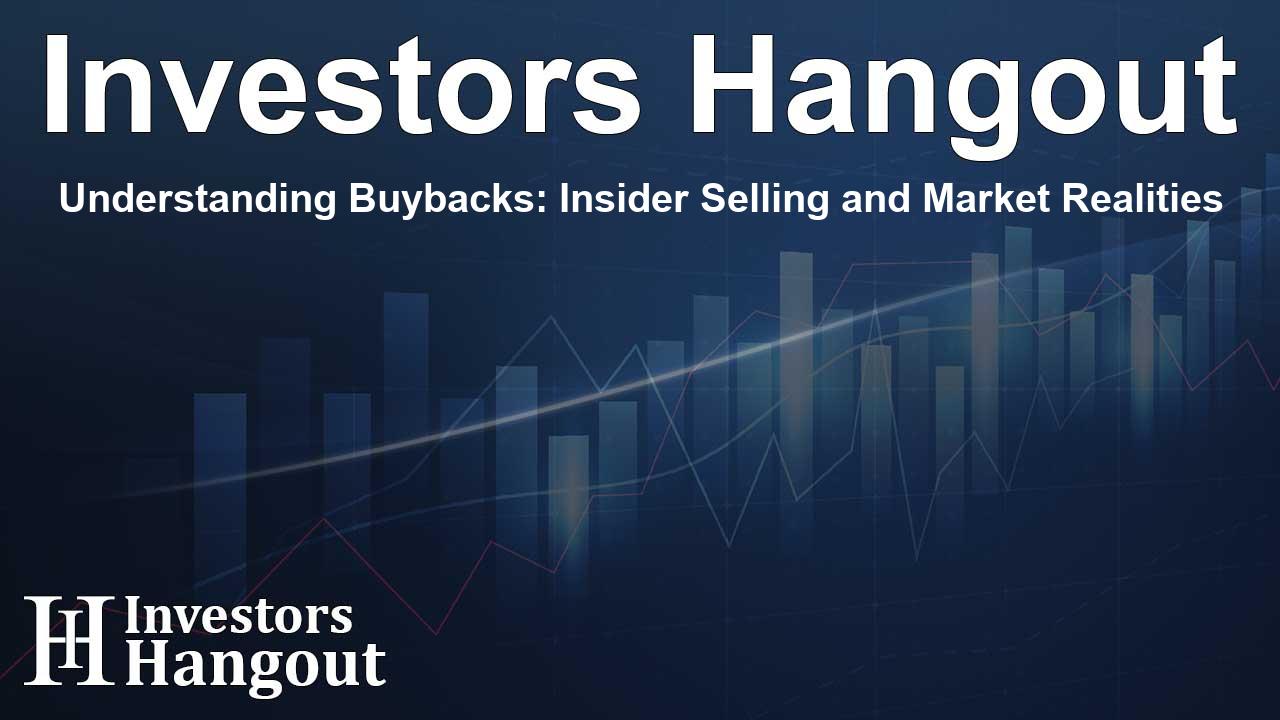Understanding Buybacks: Insider Selling and Market Realities

Unpacking the Myths of Stock Buybacks
Common discussions often echo a simplistic belief: “Buybacks return capital to shareholders.” At first glance, this seems to make sense. When companies reduce their number of shares, each shareholder theoretically receives a bigger piece of the earnings pie. However, the situation is far more intricate than that. If buybacks were truly meant as a direct return of capital, akin to dividends, it would mean providing actual cash benefits to all shareholders equally. In reality, though, buybacks primarily end up favoring particular groups, particularly insiders who sell their shares.
What Does This Imply?
For individuals to gain from corporate buybacks, they must first sell their shares back to the company. Those who decide to hold on to their shares do not receive any immediate compensation. The only potential upside for them might be an increase in their ownership percentage, which becomes irrelevant if the company's true value doesn't appreciate.
Recent statistics on insider trading coupled with corporate buybacks shed light on this disparity. During one month alone, S&P 500 companies declared a staggering $166 billion in buybacks, marking an unprecedented figure for July.
However, to enable these buybacks, there needs to be a seller of shares. So the question arises: who is primarily selling their shares?
It’s the corporate insiders. Why are they selling? Over the years, there have been shifts in compensation frameworks that have resulted in increased reliance on stock-based compensation for corporate executives. As a result, they frequently liquidate the shares provided to them as part of their compensation packages to convert these stocks into tangible wealth. As highlighted in previous commentary:
“Executives often provide various reasons for stock buybacks, but none are as effective at explaining the practice as this simple truth: Stock compensation constitutes a major part of their earnings, and buybacks tend to elevate stock prices in the short term.”
Additionally, a study conducted by the Securities & Exchange Commission revealed similar findings:
- SEC research indicated that many corporate executives sell significant amounts of their shares after announcing stock buybacks.
Intriguingly, data from July supports this perspective.
Insider selling hit its peak since at least 2018, with only 151 companies reporting any insider buying activities. This equates to less than one-third of firms witnessing insiders increasing their stakes. If buybacks were a genuine sign of capital return confidence, those in the know—insiders—would be buying more shares alongside the company. But they weren't.
Often, buybacks are employed for another purpose: inflating earnings per share (EPS) without enhancing actual profits. This manipulation can assist corporations in achieving Wall Street targets, triggering executive bonuses, and maintaining short-term stock price momentum. For insiders looking to sell, this creates an ideal scenario. They can announce a buyback, let the stock price rise, then sell during that uptick. While it's legal under SEC provisions, the same tactics prompted the SEC to ban buybacks prior to 1982.
In essence, the notion that “buybacks return capital to shareholders” is more of a misleading narrative. For many companies, “buybacks denote capital returned to insiders who are selling.”
July Data Raises Important Concerns
It should trigger alarms when record buyback figures coincide with spikes in insider selling within the same timeframe. July's reported $166 billion in buyback announcements coincided with a notable increase in insider transactions. This situation is not surprising given the market's significant rebound since the lows observed in April. For those within the company sitting on substantial gains from option-based compensation, it's logical to convert those gains into real value. However, these statistics should also signal caution.
Let’s delve into the so-called “strong earnings season” in Q2. Yes, a considerable share of companies surpassed estimates.
Nonetheless, investors should interpret this information cautiously for two reasons.
First, from April onwards, overall GDP growth expectations for Q4 decreased by about a percentage point while the earnings outlook for the equal-weight S&P 500 dropped approximately 6%. Low expectations set a minimal benchmark for surpassing. Presently, with three-quarters of the reporting season completed, over 80% of S&P 500 firms have reported earnings exceeding expectations, outpacing the 10-year average of 75%.
Second, as noted in previous assessments, the overall economic weakness appears apparent. The growth in earnings wouldn’t have materialized without the contribution of Megacap Technology and leading Wall Street banks.
Thus, while the market may seem thriving at a glance, there is a significant correlation between corporate share buybacks and market performance.
It's not an isolated occurrence. Corporations may find insiders more inclined to sell—and at larger volumes—as share prices climb. As a result, the timing of insider selling juxtaposed with corporate buybacks tends to be intentional. When a buyback decreases the share count, it boosts the EPS. Wall Street often rewards these EPS beats, typically causing the stock price to rise temporarily. Insiders can then capitalize on this strength to offload portions of their holdings at a premium.
July's figures align perfectly with this pattern. While management teams sanctioned billions in buybacks, the most knowledgeable parties about the company's future were not investing alongside the retail investor. Instead, as the float diminished, it created a façade of improving performance, all while insiders discreetly cashed out.
This isn’t a true return on capital; rather, it signifies a capital shift from corporate coffers to those unloading their shares.
Investors should maintain a consistent evaluation of buyback initiatives in relation to insider activities. A buyback occurring alongside insider selling does not indicate confidence; instead, it often signifies an executive liquidity event. Despite the hefty buyback promises, the lack of insider buying in July communicates volumes more than any corporate announcement.
Understanding the Implications: EPS Management and Risks for Investors
A recent article from Jason Zweig articulated the following:
“Over the last five years, according to S&P Dow Jones Indices, major U.S. corporations have spent $3.9 trillion repurchasing their own stock. Buybacks are inherently neutral; they are merely a mechanism. Used correctly, they can be beneficial; used poorly, they can be detrimental.” – Jason Zweig, WSJ
This represents a balanced viewpoint. The influence of stock buybacks is crucial in facilitating earnings growth, primarily as earnings are evaluated on a per-share basis. In simpler terms, reducing the number of outstanding shares leads to an apparent improvement in corporate earnings “per share.”
The relationship between insider selling and buybacks extends beyond mere optics; it signifies a profound misallocation of shareholder capital.
“But what if the company is genuinely confident about its future?”
Indeed, such circumstances may arise. However, if I were genuinely optimistic about the trajectory of my business, why wouldn’t I choose to allocate my resources towards investments or assets that can enhance future revenue and growth? Consider the case of Apple Inc (NASDAQ:AAPL). Over three years, revenue and earnings growth have stagnated while the company repurchased over $500 billion of its stock.
However, new pressures from the administration about impending tariffs compelled Apple to allocate $600 billion over five years for corporate investments rather than merely repurchasing shares. Does this reflect “conviction” about the company’s future or a defensive strategy to secure existing profits? If committing $600 billion is a “wise move,” why didn’t Apple opt for that strategy years ago?
For companies engaging in share buybacks, such actions haven't typically favored all shareholders. The decreased share count inflates EPS, aiding management in achieving quarterly objectives. Yet, these increases may not correspond to an uptick in intrinsic value. This is precisely why the SEC originally banned buybacks—they were viewed as a form of market manipulation.
Investors should exercise caution in understanding the ramifications of buybacks on earnings when choosing to invest in businesses. As noted by Warren Buffett:
“It’s essential to recognize that even our preferred earnings figures can be easily manipulated by managerial wills. This kind of manipulation, often regarded as sophisticated by CEOs and their advisors, is an issue of concern. Many analysts and reporters also share in this view, heralding ‘beating expectations’ as a managerial success. Manipulating numbers is less about skill and far more about a desire to deceive.”
Why do CEOs resort to manipulating earnings? Understandably, a survey conducted by the WSJ revealed that 93% of CFOs cited “influence on stock price” and “external pressures” as motivations for adjusting earnings figures.
When insiders cash out in a seemingly “optimistic” climate, they profit from inflated valuations while remaining shareholders are left holding a perhaps overpriced stock. With time, this kind of strategy can diminish shareholder yields, particularly if companies divert funds from productive endeavors, like research and development or debt repayment, into buybacks aimed at sustaining metrics.
The statistics from July should be taken as a cautionary tale. Record buybacks coupled with historically low insider purchases serve as a glaring warning. They suggest that insiders may not view the stock as undervalued or may not possess as rosy a growth outlook as anticipated. They also make clear that the primary beneficiaries of the buyback strategy are the insiders themselves.
For those investing for the long term, this poses significant challenges. Resources utilized for financial engineering today are resources not allocated toward future growth.
Keep a close watch on insider transactions if you’re analyzing a company with active buyback programs. Identify trends where buybacks coincide with substantial insider selling. Such patterns frequently precede a downturn in performance.
Remember: dividends effectively return cash to you as a shareholder. Buybacks only serve you if the stock is objectively undervalued, and insiders are retaining rather than selling their shares.
In July, that was decidedly not the case.
Frequently Asked Questions
What are corporate buybacks?
Corporate buybacks refer to companies purchasing their own outstanding shares to reduce the number of shares on the market, aiming to boost shareholder value.
How do buybacks affect share prices?
Buybacks can influence share prices positively by reducing supply, often leading to an increase in share value as demand rises.
Why do insiders sell shares during buybacks?
Insiders often sell shares during buybacks to convert their stock-based compensation into actual wealth, taking advantage of favorable market conditions.
What risks do buybacks pose for long-term investors?
Long-term investors may face risks if the buybacks artificially inflate stock prices without improving the company's underlying value, leading to potential overvaluation.
How should investors evaluate buybacks?
Investors should assess buyback programs in light of insider activities, looking for signs of confidence or potential manipulation through insider selling during buybacks.
About The Author
Contact Henry Turner privately here. Or send an email with ATTN: Henry Turner as the subject to contact@investorshangout.com.
About Investors Hangout
Investors Hangout is a leading online stock forum for financial discussion and learning, offering a wide range of free tools and resources. It draws in traders of all levels, who exchange market knowledge, investigate trading tactics, and keep an eye on industry developments in real time. Featuring financial articles, stock message boards, quotes, charts, company profiles, and live news updates. Through cooperative learning and a wealth of informational resources, it helps users from novices creating their first portfolios to experts honing their techniques. Join Investors Hangout today: https://investorshangout.com/
The content of this article is based on factual, publicly available information and does not represent legal, financial, or investment advice. Investors Hangout does not offer financial advice, and the author is not a licensed financial advisor. Consult a qualified advisor before making any financial or investment decisions based on this article. This article should not be considered advice to purchase, sell, or hold any securities or other investments. If any of the material provided here is inaccurate, please contact us for corrections.
